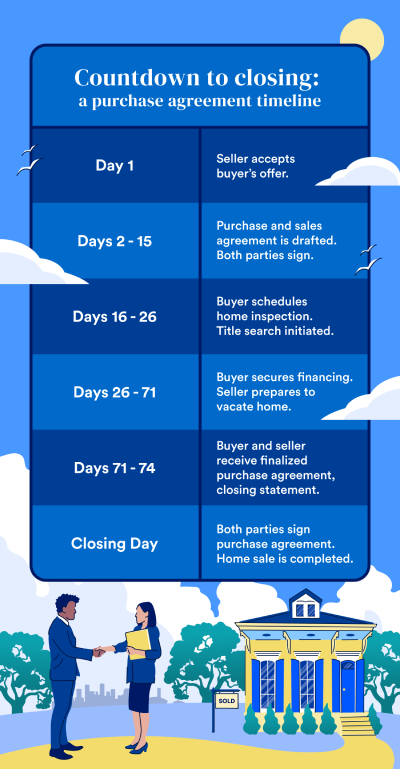What is a purchase agreement?

The Bankrate promise
At Bankrate we strive to help you make smarter financial decisions. While we adhere to strict , this post may contain references to products from our partners. Here's an explanation for .
You’ve been searching for several months, and you’ve finally found a home you love in a great neighborhood. After negotiating with the seller, you settle on a price you both agree upon. You sign an agreement, put down a deposit, and eventually, you’re at the closing table concluding the transaction — or executing a purchase agreement, as they say in real estate lingo.
But what does a purchase agreement entail? What if there are certain terms and conditions involved in your home purchase?
Here’s everything you need to know about purchase agreements, what they include, and the timeline for creating one.
What is a purchase agreement?
A purchase agreement, also referred to as a purchase contract, real estate sales contract, or real estate purchase contract, is an agreement between a buyer and seller that spells out the terms of a real estate transaction. As its name suggests, it’s a contract to purchase a property.
In addition to basic information like the property address and price, the document often outlines any contingencies that must have occurred before the sale is binding and specifies what rights the buyer has regarding seller obligations, and vice versa. For instance, if the sale is contingent on a satisfactory home inspection, that would be mentioned in the purchase agreement. Typically, contingencies come with a specific timeframe in which they must be met.
While similar in name to a purchase and sale agreement (PSA), the purchase agreement or contract is generally signed at the closing. “Typically, purchase and sale agreements are drafted earlier in the process. The buyer, seller or both must meet certain contingencies before a contract is drawn up and a transaction is finalized,” says Christine Finch Oleynick, Realtor with Keller Williams Luxury Realty. That being said, purchase agreement is sometimes used interchangeably with PSA.
What should a purchase agreement include?
The information outlined in a purchase contract can vary by state but it usually includes:
| Buyer and seller names | The legal names of all parties involved in the transaction, who have held or will hold title to the home. |
| Property information | The property address, square footage, and land plot information. |
| Price and financing information | The home’s final purchase price and the amount of the mortgage, if any, the buyer has taken out for the purchase. |
| Possession date | The possession date: when the buyer can take control of the property. |
| Closing date | The date the transaction is finalized, and the home officially changes hands. |
| Inclusions/exclusions | Any fixtures that the seller plans to leave behind, such as a washer/dryer or oven range, as well as any major items/furnishings they are taking with them. |
| Earnest money deposits | Sums indicating good faith the buyer has made, typically put into an escrow account. |
| Closing costs | Any closing costs required, as well as who pays them. |
| Contingencies | The contingencies that need to be met before a transaction is finalized. Common contingencies include home sale, home inspection, appraisal and financing contingencies. Contingencies often come with a set time frame. For instance, a buyer might need to secure financing by a certain date. |
What’s not covered in a purchase agreement?
While the purchase agreement provides a fairly comprehensive summary of a real estate transaction, you probably won’t see a specific breakdown of fees in this document.
For instance, if you want to see what’s included in your closing costs, you’d probably need to look at your settlement statement or closing statement, which you typically receive a few days before the closing. You’ll likely only see the final figure on the purchase agreement.
How binding is a purchase agreement?
If a seller or buyer fails to meet a contingency within the time frame outlined, it’s possible to back out of the purchase. “But once contingencies are negotiated and met, the lawyer then drafts a purchase contract. After the buyer and seller sign that purchase contract, it’s a binding agreement,” Oleynick says, “However, it’s important to ask your Realtor or closing agent about the specific process in your state, as it can vary depending on where you live.”
Make no mistake: Despite the innocuous-sounding “agreement,” this is an official contract. It can be difficult for either party to back out of a purchase agreement (or even a PSA), and doing so could cost them money. Purchasers feeling buyers remorse will likely forfeit any earnest money deposits to the sellers, and second-guessing sellers could face legal action from the buyers.

Purchase agreement timeline
While the process and time needed to purchase a home can vary based on your state, here’s what you might expect:
- Buyer’s real estate agent drafts an offer letter once the buyer finds a home they’d like to purchase.
- The seller’s agent shares the offer with the seller. Typically, sellers will either accept, reject, or counter-offer within one day.
- If a buyer and seller choose to negotiate on pricing, this can take a few days.
- If the buyer and seller negotiate successfully, a purchase and sale agreement is drafted. Both parties generally have 10 to 14 days to sign it after an offer is accepted.
- Once it’s signed, the home is “under contract” or “in contract.” At this point, the buyer has around 30-45 days to secure financing; the seller has that amount of time to vacate the home.
- If there are contingencies outlined in the purchase and sale, both the buyer and seller will need to have met them within the timeframe specified, or either party could back out of the transaction. For example, buyers might have a week to 10 days to schedule a home inspection.
- Around three business days prior to closing, both the buyer and seller will receive a copy of the finalized purchase contract, along with a closing statement or settlement statement — a sort of balance sheet of costs — from the closing agent.
- On closing day, the purchase contract is signed by both parties and the home sale is complete.
Related Articles



